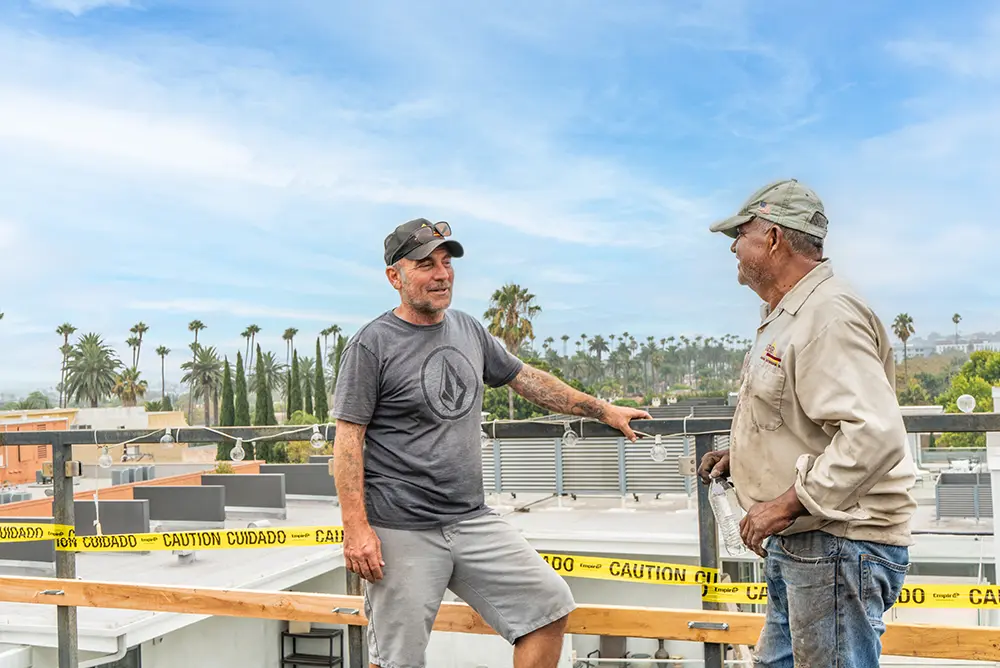By Dan Cahill and Gary Stewart
In the dynamic world of commercial roofing, understanding the specific roles and responsibilities of a commercial roofer is crucial for business owners, landlords, property managers, and HOA property managers in Southern California. At SBR Roofing, we recognize that your roofing needs extend beyond mere installation; they encompass a comprehensive range of services designed to maintain and enhance the integrity of your commercial properties. This article aims to clarify the scope of services provided by commercial roofers, highlight key considerations for maintaining or replacing roofing systems, and equip you with the knowledge necessary to make informed decisions when selecting a roofing contractor.
Seasonal Responsibilities of Commercial Roofers
The activities of commercial roofers fluctuate throughout the year, primarily influenced by seasonal weather conditions. During the warmer months, many contractors concentrate on installing new roofs, re-roofing, and managing large projects, as the sunny and dry climate provides optimal conditions for these tasks. In contrast, the winter months of December, January, and February typically coincide with the rainy season, making re-roofing less common. Instead, the focus shifts to addressing leaks and troubleshooting existing issues. Additionally, between these peak periods, a maintenance cycle is essential for preserving the integrity of roofing systems. Thus, the responsibilities of a commercial roofer are not static; they adapt to the changing seasons and the specific needs that arise throughout the year.
Key Responsibilities of a Commercial Roofer
A commercial roofer plays a vital role in tenant improvements across various building types, including offices, warehouses, and manufacturing facilities. This work often involves repurposing spaces, such as converting sections of a warehouse to expand office areas or installing new manufacturing equipment that requires proper exhaust systems. These installations necessitate venting through the roof to manage fumes effectively.
In addition to hands-on installation tasks, commercial roofers also engage in essential administrative duties. Regular inspections are conducted to keep clients informed about the condition of their roofs, ensuring they are aware of any potential issues before they arise. Annual or semi-annual inspections help identify changes since the last assessment, allowing for proactive measures to address potential problems. This process includes not only the inspection itself but also generating a detailed report that summarizes observations and provides recommendations for necessary actions. While this aspect may seem more aligned with office or sales functions, it remains a crucial component of the overall service provided by commercial roofers.
The Importance of Summer for Commercial Roofing Quality
Many people view working in the heat of July and August as undesirable, but this perception is misleading. For commercial roofers, these hot months are often the most advantageous for getting the job done. While the conditions may not be the most pleasant, the warm and dry weather allows roofers to focus on quality rather than speed. In contrast, during fall, winter, or spring, the threat of rain creates a sense of urgency; roofers must rush to cover the roof before storms arrive, often needing to complete work by a specific deadline. The summer heat alleviates this pressure, enabling a greater focus on delivering a high-quality finished product, which ultimately benefits both clients and contractors.
Additionally, many roofing companies specialize in specific areas such as new construction, leak repairs, or re-roofing. In contrast, our approach is to excel in all facets of roofing, providing customized solutions that cater to the unique needs of each client. Different buildings have distinct requirements; for example, while all structures need a leak-proof roof, the specifications for a Home Depot or warehouse—often featuring HVAC units and skylights—differ significantly from those of a food processing facility, which requires intricate exhaust systems, grease management, and refrigeration considerations. We take pride in our ability to address these varied roofing challenges, ensuring we are not confined to a single niche but are equipped to handle a wide range of projects effectively.
Conclusion
The expertise of a commercial roofer is invaluable in ensuring the longevity and functionality of your roofing systems. By understanding the seasonal responsibilities, key tasks, and specialized knowledge that commercial roofers bring to the table, you can make informed choices that protect your investments. At SBR Roofing, we are committed to delivering exceptional workmanship and customized solutions tailored to the unique needs of your property. With over 60 years of experience, we stand ready to assist you with any roofing challenges you may face, ensuring that your roof remains a reliable asset for years to come.
Protect your investment with expert service—choose SBR Roofing for reliable commercial roofing.
Author Bio
As a proud fourth-generation commercial roofing contractor, Gary Stewart has dedicated his career to upholding the legacy of quality and craftsmanship established by his family. Today, as a managing partner, he works alongside his relatives, blending tradition with innovation to deliver exceptional roofing solutions. His commitment to excellence and teamwork not only strengthens SBR Roofing’s projects but also deepens those family bonds, ensuring that every roof we build is a testament to our shared values of integrity, durability, and service. Together, we are not just constructing roofs; we are building a future for our community and our family lineage.
Dan Cahill embarked on his journey in 2001, accumulating over 23 years of experience in the commercial roofing field. The original owner of SBR Roofing extended a trial opportunity in 2001, coinciding with the burst of the dot-com bubble. The proposition was simple: give it a year, see if it suits you, and if not, no hard feelings. Surprisingly, Dan found himself sticking around. Fast-forward over two decades, and he continues to thrive in the field.
With a background in sales, Dan discovered a passion for the dynamics of salesmanship, particularly in the freedom it offered from the confines of a desk. The opportunity to engage with people, navigate various situations, and even climb up on roofs appealed to him. This intriguing experience kept Dan hooked, prompting him to stay the course, eventually becoming a leader in the roofing industry.







